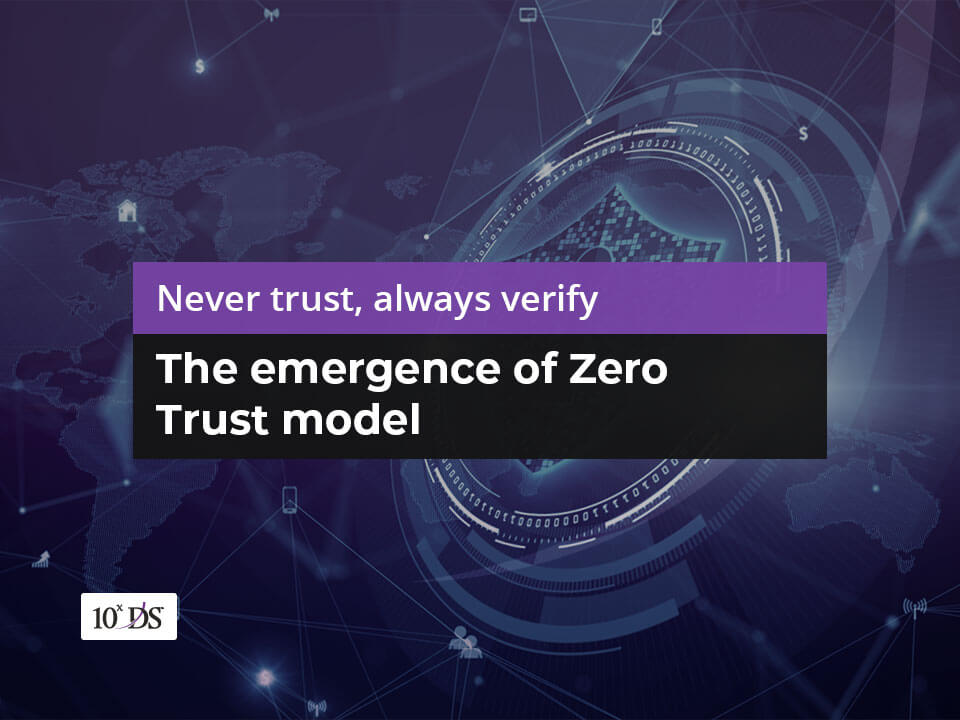
Never trust, always verify – The emergence of Zero Trust model
Due to the current scenario and circumstances where cyberattacks and data breaches have become commonplace in the past few years. So, a new security model has emerged which is called the Zero trust model.
We are all taught to trust each other from our childhood even though well-intentioned warnings and common-sense precautions about strangers were always there. Extending trust is in fact necessary for individuals and organizations to work efficiently. Trusting someone means that you think they are reliable, and you have confidence in them, and you feel safe with them. Trustworthiness is considered a supreme quality for anyone to be part of a group or organization. However, considering how modern digital businesses work there is a paradigm shift in this thought process and now businesses have started going with a principle that ‘never trust’ and ‘always verify’.
Traditional security models operated on the assumption that everything inside an organization’s network can be trusted, however, this trust is considered a vulnerability now. It is treating users whether internal or external like “total strangers” and unless the organization verifies who that is, they are “not authorized to access anything”.
The Zero trust model is becoming a widely accepted framework in the time when data breach costs are on a rise despite organizations spending more and more on their cyber security efforts. Cost of a Data Breach Report 2020 by IBM suggested that Global average total cost of a data breach in 2020 is $ 3.86 million per incident. Since it was first coined by Forrester Research in 2020, it is being adopted by many organizations.
Core Principles behind Zero Trust model
Here are some core principles and guidelines behind Zero trust model:
- Strict identity verification for every person trying to access resources on a private network, regardless of whether they are inside or from outside.
- Least-privilege access by giving users only as much access as they need.
- Micro-segmentation by breaking up security perimeters into small zones to maintain separate access for separate parts of the network.
- Multi-Factor Authentication requiring more than one piece of evidence to authenticate a user; A single password cannot really authorize a person to access.
- Controls on device access by monitoring how many different devices are trying to access their network and ensure that every device is authorized.
Achieving Zero Trust
Zero Trust can be built upon existing architecture without replacing existing technology and adopting security products that work well in a Zero trust environment. This is a transformation that if implemented by design yields better results than by retrofit. Implementing technologies that can help achieve Zero Trust and replacing old legacy systems will be a huge jump in this direction. CISOs, CIOs and other executive tiers need to be equally involved to decide what are the priority items that need to be moved to this model and what can wait.
Palo Alto Networks suggests an iterative five-step methodology for the deployment of your Zero Trust network with ease.

Source: Palo Alto Networks
1. Define Protect Surface
First and foremost, step is defining the sensitive Data, Applications, Assets and Services (DAAS) that an organization needs to protect, which makes up the protect surface.
2. Map Transaction Flows
Data traffic across the network in the protect surface determines how it should be protected. This understanding comes from scanning and mapping the transaction flows inside your network to determine how various DAAS components interact with other resources on your network and this will allow knowing where to insert controls.
3. Architect a Zero Trust Network
Architecting the network is the third step. Major components of the architecture will be a segmentation gateway to enforce granular Layer 7 access followed by least-privileged access control, inspection, and logging of every single packet through Layer 7. This is done by inspecting all network traffic for malicious content with multiple integrated security services, including intrusion prevention systems (IPS), sandboxing, URL filtering, DNS security, and data loss prevention (DLP) capabilities.
4. Create the Zero Trust Policy
Next step involves creating the Zero Trust policies which should answer the who, what, when, where, why, and how of your network will be needed to support and allow only known traffic or legitimate application communication in the network.
5. Monitor and Maintain the Network
The final step is to continuously look at all internal and external logs through Layer 7 and focusing on the operational aspects of Zero Trust. Inspecting and logging all traffic on your network is a pivotal facet of Zero Trust and all this traffic data will give insights into how to improve Zero Trust network over time.
Conclusion
In order to safeguard organizations from the ever-evolving threat landscape, they need to transform how they manage security. Adoption of the Zero Trust model is one important step towards fortifying your security systems. It is indeed a powerful prevention strategy when implemented across the entire environment—the network, endpoint, and cloud.
Talk to NXSecure experts to know more about the Zero Trust model and advanced security technologies to minimize risk and protect your critical data assets.


